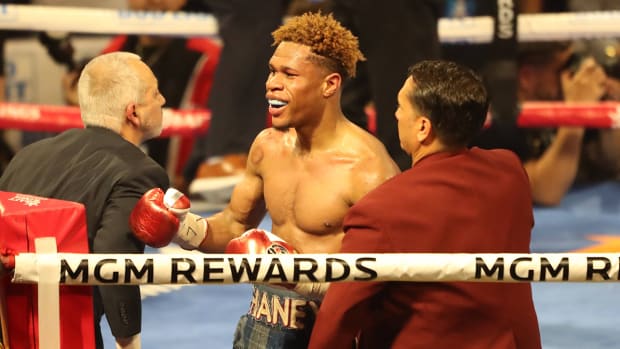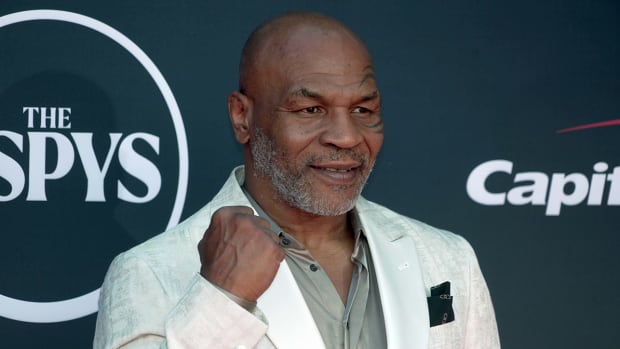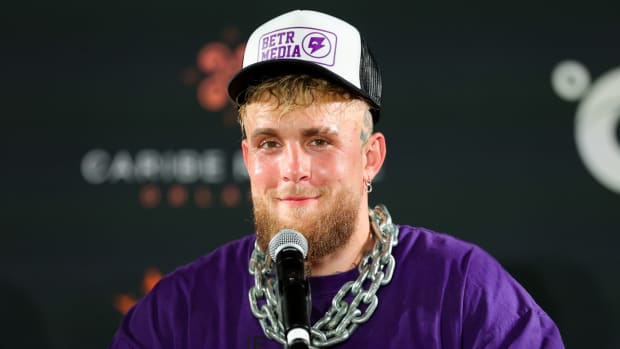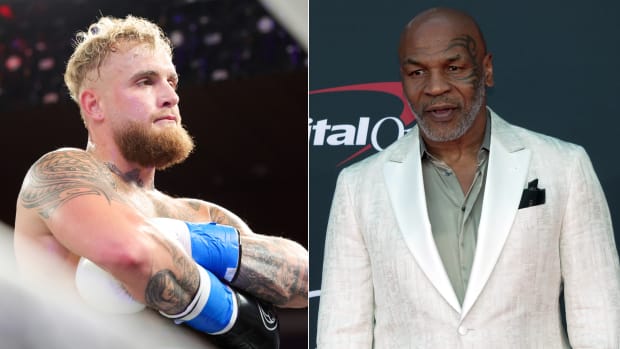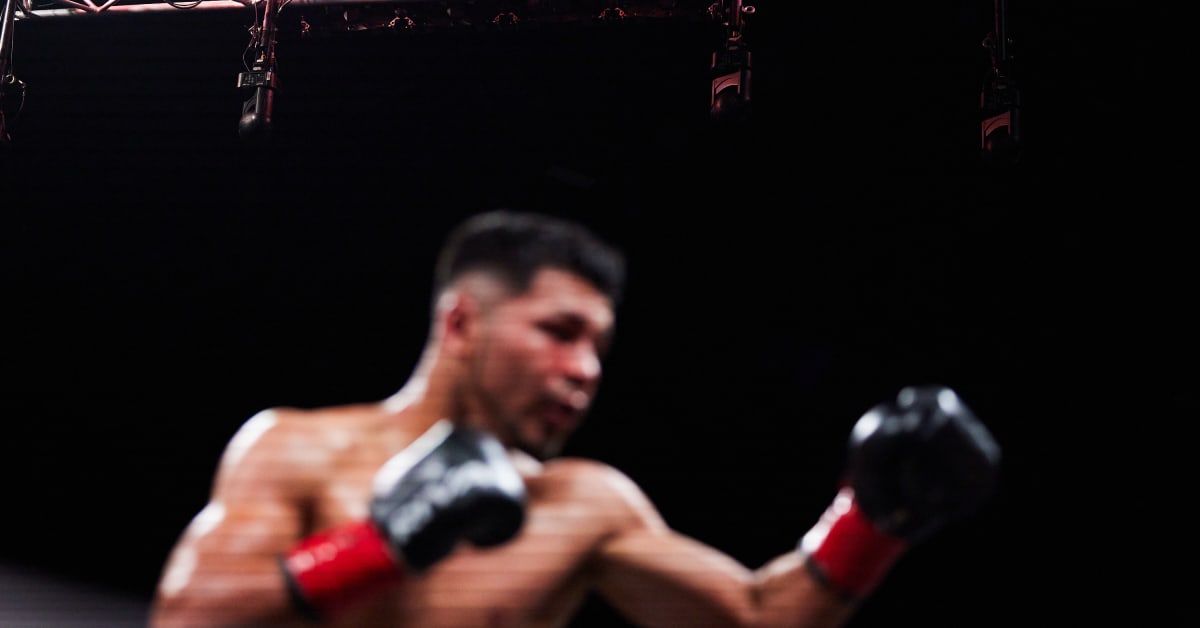
Showtime’s Over: Boxing Enters the Post-Network World
The Benavidez Sports Boxing Gym bustles with activity in mid-November. It’s sparring day for the gym’s two namesake brothers, David and José Jr., both professional boxers who moved to the Seattle area a few years back and built an unlikely fight hub inside a nondescript strip mall near the airport.
David sits underneath the ring, his T-shirt drenched in sweat, shouting instructions to his older brother. “Come back with the right hook!” Junior keeps jabbing and striking, finishing every round with lengthy flurries of punches. “More action!”

Last weekend’s card in Minneapolis was Showtime Sports’ final boxing event.
Adam Bettcher/Getty Images
Behind them, opposite the shelves stuffed with merchandise, banners hang from every wall. Some announce the upcoming card both will fight on, with David headlining against Demetrius “Boo Boo” Andrade and Junior against undefeated Jermall Charlo. Others stretch the length of a wall. Many feature the logo of the network upon which the fighting Benavidez brothers have most often plied their trade: Showtime.
The gym oozes the kind of urgency that always builds before big bouts. There’s anticipation, born from David’s status as one of the most feared champions in boxing. There’s camaraderie, owing to the brotherly twinbill. There’s serenity, following familial healing in recent years. And there’s familiarity, in participating in a scene repeated daily in gyms all over, the types of places where traditions are respected and hygiene is suggested.
Gyms like the Benevidezes’ build newbies into prospects and transform prospects into contenders. For years, most of those fighters held the same goal: to fight on HBO or Showtime.
Hence the sadness also hanging heavy in the air. HBO shut down its boxing operation five years ago. Showtime Sports, where boxing was the primary driver, will shutter this month. (Disclosure: I have worked since 2018 as a writer and producer on Showtime Sports’ boxing programs.) David’s clash with Andrade was slated for the network’s final pay-per-view spectacle, on Nov. 25, and while he considers the slot an honor, this is not the type of history he is eager to make.
“I never saw it coming,” he says. “It’s a little sad. Not a little. Very sad. Yeah, it’s going away.”
As part of a boxing family, David was bred on HBO and Showtime. His favorite fight might be Diego Corrales–José Luis Castillo I (2005). Mike Tyson recently bestowed David with a nickname, The Mexican Monster, and his style of fighting, all will and power, is Corrales-Castillo inspired. It started that very night.
Each subsequent discovery led him deeper, even back into the classics: Hagler-Mugabi (the first ever fight shown on Showtime), Duran-Barkley, Tyson-Holyfield I. Benavidez dove even deeper on the three champions who fought the most times on the network: Tyson, Holyfield and Julio Cesar Chavez.
David wanted to fight like them, like that, on “platforms where legendary fighters have legendary fights.”
Then he made it there, faster than anyone expected, after 11 victories, 10 of which were stoppages. Right after turning 18, before he became boxing’s youngest world champion, before he lost one belt for a failed drug test and another for not making weight, he made his Showtime debut. That night, Nov. 14, 2015, is burned into his memory. Opponent: Felipe Romero. Setting: Hard Rock, Las Vegas. Jitters: present. Result: first-round KO.
That marked perhaps the first time David felt he had really made it. The network immediately offered him a contract. He earned every penny, then set aside his worst habits to focus more intently on all the opportunities life had spread before him. He reunited with his estranged father and older brother, got married, became a father.
As David’s life aligned, his career elevated even higher. Phrases like next face of boxing began circulating. Elite champions became increasingly creative in avoiding him, while the ones who didn’t wished they had. He was compulsively watchable—for that style, for the knockout rate (85.7%), for whom he bludgeoned and whom he promised to bludgeon. Showtime, through docuseries like the one I worked on, All Access, brought his story to a wider audience. “So many people gravitate toward me, especially in boxing,” he says. “Because I really do believe I can beat anybody they put in front of me. And not only beat them, but beat the s--- out of them.”
He laughs, because after all that—right strategy, right approach, right steps, right tweaks, right network—right as he arrived near the pinnacle, the sport shifted away from Showtime, which is being folded into another of its parent company’s brands, Paramount+. The end of Showtime Sports won’t impact a boxer of David’s caliber. But it could impact other up-and-comers, as another stage for an increasingly niche sport goes dark.
Whether you love boxing, disdain the violence or throw books across rooms trying to figure out the alphabet soup of belts and promoters and posturing, the questions moving forward are incredibly complex. Is David the last face of boxing? Or the centerpiece of yet another new frontier?
This past Saturday, Showtime aired its final fight: bruising David Morrell Jr. vs. thunderous Sena Agbeko in Minneapolis. Four days before that, the network’s sports czar called from his office in Manhattan. The fight is enticing, but he knows that’s not the reason for the conversation. The finality is—for him, but also, after 37 years, for the network.
“It sucks,” he says. “It’s sort of like moving, the last part, where you’re just packing up s--- that you never wanted to pack up.”
Stephen Espinoza took over Showtime Sports in 2011. He was in boxing before that, working for luminaries like Oscar De La Hoya, interacting with networks like the one he came to run. As he packs, memories abound.
Some Espinoza had long ago forgotten. He has been thumbing through files, which show how much toil and strategy and financial planning go into fashioning a major card. The events themselves always rendered those files afterthoughts.
Some of the mementos he comes across are funny. Like his collection of signed boxing gloves, the funny part being how few he actually labeled. Some signatures are unrecognizable. One is signed by Danny Garcia, the former multiple-division champion, along with someone else. But the signature doesn’t match any of Swift’s opponents.
Other memories don’t seem real, because they’ve become more surreal over time. Like the press tour for Floyd Mayweather Jr. and Conor McGregor, where McGregor went in on Espinoza, goading tens of thousands to boo a boxing executive. Or the night Anthony Joshua shocked millions by toppling Wladimir Klitschko in front of 90,000-plus at Wembley Stadium. Or the time Errol Spence Jr. went to the United Kingdom, stalking into Sheffield to dethrone Kell Brook, winning his first world title as fans pelted him with brownies while he left the ring.
“The goose bumps and the adrenaline of fight night, big or small, it never gets old,” Espinoza says, a bit wistfully.
It all happened so fast, The End, this end. Showtime Sports wasn’t certain to continue when Paramount+ came into existence. There were whispers—in boxing, from colleagues at Showtime or in the sport—that the network might follow HBO. Most felt Showtime would stage fights at least through 2024.
This year’s slate might have been Showtime’s best—as in, ever. Espinoza made the kind of bouts that mainstream sports fans lament don’t exist anymore—the kind that featured young and veteran and hungry contenders or champions with futures at stake and considerable risk for all. Gervonta “Tank” Davis continued his ascendance, knocking out Ryan “King” Garcia in May. Terence Crawford so thoroughly battered Spence that Spence, typically the batterer, became sympathetic in defeat. That’s the single best performance I’ve seen in person, from a pool of more than 50 cards since 2008. Canelo Álvarez returned to the network and signed a three-fight deal with its partner, Premier Boxing Champions. Benavidez continued to thrill not just fans but other champions. And that’s just a partial list.
Signs seemed to point both ways. Imminent death. Not even close. Headlines that read “Why HBO and Showtime Died: It’s All Jake Paul’s Fault” weren’t that accurate. They pointed to one issue, rather than the combination that’s shifting boxing’s landscape.
Those who engaged in a little grave dancing, like UFC president Dana White, also missed key points. Espinoza did a ton of good for boxing. And MMA champions who fought on Showtime PPV made a hell of a lot more money than they ever did in MMA.
So many unfounded, puzzling and false notions floated all over. Yes, market dynamics were changing. But streaming boxing remains complicated. (DAZN, the sport’s largest streaming service, lost $2.33 billion in 2021, according to Sports Business Journal, which also reported DAZN losses of more than $5 billion between ’19 and ’21.) That’s where the streaming calculus gets complicated. Streaming services have made boxers, their management teams and their entourages not rich but wealthy. But the entities themselves, like DAZN but also others, haven’t found a way to monetize the shifting landscape for themselves.
Every Showtime pay-per-view blockbuster staged in ’22 meant a reduction in quality for Showtime Championship Boxing, the series that served as the network’s bedrock. That owed, in part, to DAZN inflating the price of events, by overpaying fighters. As everyone’s price went up, better fights got moved to pay-per-view to ensure profit. The regular network cards suffered. HBO saw these dynamics and exited. Showtime saw and tried to fight against.Cards featuring celebrities, former athletes and every conceivable circus act have become a permanent part of the scene. But Showtime was in on that trend early. Media is changing, but it’s not changing just for Showtime or HBO. Espinoza led pivots in recent years—into streaming, documentaries, docuseries: everything digital, meant to adapt the product. Real champions still pack arenas; blockbuster bouts still perform well on PPV and at the gate.
All of this adds up to a broken model. Showtime is the latest victim. It will not be the last.
Bittersweet is how Espinoza describes the last year. “You never want something like this to end,” he says. “But if it had to, I’d rather end on perhaps the best year ever for Showtime Sports. It does justice to our contributions. And it helps elevate the sport for whoever is going to step into that place moving forward.”

That final Showtime card was headlined by Morrell (right), the undefeated WBA super middleweight champion who defeated Agbeko (left) by knockout in the second round.
Saul “Canelo” Álvarez understands the questions, the emphases on legacy, time left, what’s next. How much longer will he box? Which weight class? Against whom? Alvarez is 33 years old and has boxed professionally for more than half his life; his legacy requires no burnishing; his career—60 wins, 40 knockouts, world titles in four divisions—already guarantees the Hall of Fame.
Perhaps those wondering don’t grasp what drives him, which is why they’ll never understand what it took. “I love boxing,” Alvarez says. “I love this sport.”
He wants to be remembered “as one of the greatest fighters ever.” And the best of Mexico’s many champions.
Canelo considers all this over Zoom, his facial expression serious, in contrast to his bright pink tank top and matching hat. He can’t shake legacy, the importance of it. For networks like Showtime. For champions of his caliber. For others coming up in an ever-shifting landscape.
He waves away any notions that he has made it to the Floyd years, when monetary aims supersede challenges and their inherent risk. “I like being in this position,” he says. “When I’m involved in big fights, dangerous fights, they make me train harder. Make me feel alive.”
Whether boxing lasts as long as his career, whenever it might end, doesn’t strike Álvarez as a serious question. It will, he and most in the industry believe. But in what form?
As another end approached, Álvarez followed all the machinations. He believed PBC would find another home. He certainly heard David Benavidez clamor for a bout. And yet, many elements still needed to align. “I don’t have to do this, take these risks,” he says. “But I’m a boxer. This is who I am.”
That sentiment goes for all those in boxing I spoke to.
Back in the gym outside Seattle, Benavidez has Canelo on the brain. Between their collective buzz, their place in the deep pantheon of Mexican champions—Canelo lives in Mexico, Benavidez was born in Phoenix with Mexican heritage and has lived in the country—and their propensity to never back away, Benavidez sees blood. And blood means dollars, attention, one night that can propel a sport forward. That’s the plan.
Pressure, though? Benavidez claims to feel none. This is what he wanted: biggest fights, baddest opponents, genuine risk, maximum rewards. The champions who continue ducking him—he includes Canelo—are actually building confidence, because every fight he wants and cannot make proves the depth of fear he elicits.
Benavidez is convincing when he says he won’t jump from super middleweight to light heavyweight until after he beats Canelo. Not with a blockbuster—and a mega-payday—still possible. But he is headed somewhere. All Showtime fighters are.
Less than two weeks later, Benavidez climbed inside a ring in Las Vegas in an attempt to become the answer to a future trivia question—who won the last Showtime pay-per-view main event? He did, overwhelming the previously undefeated Andrade, landing flurries and prompting Tyson, who was ringside, to leap from his seat and roar. The bout lasted only six rounds, after which Andrade’s corner wisely threw in the towel. Then he hugged Tyson, with sweat dripping down his chin.
“I could die today, man,” said his father, José Benavidez Sr. “I’m that happy.”
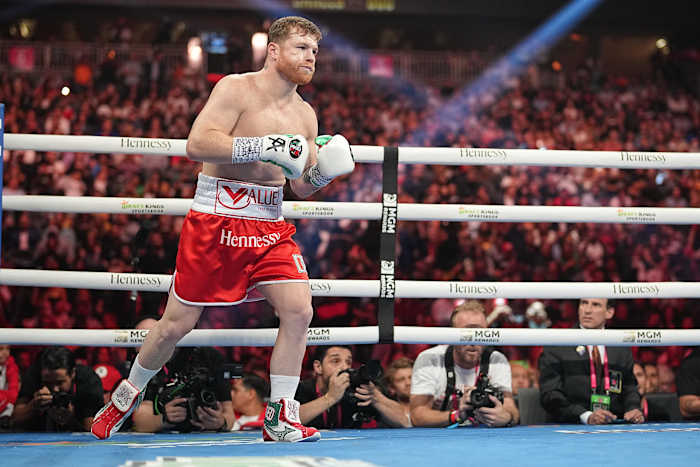
The new path to become a star like Álvarez remains an open question.
Erick W. Rasco/Sports Illustrated
Surreal and typical. That’s boxing at the end of 2023. That’s boxing, always, predictable only in how unpredictable the sport can be. When asked about the future, Benavidez floats an interesting idea. One that sort of exists now, but not really, not at the magnitude he’s suggesting.
Boxing, he says, feels ever-more divided among warring factions of promoters, fans, management companies and networks. Within that, his bouts are often compared against Paul’s versions, for skill level, purity, audience numbers, revenue. Why, Benavidez wonders, do two types of cards—that hold some crossover in audience but are largely followed by different types of sports fans—have to engage in a zero-sum exercise? Why couldn’t he, David Benavidez, fight on the same card as Paul, drawing some of Paul’s considerable audience to his considerable skill set? He wonders whether boxing cards won’t merge with MMA ones, featuring multiple combat sports in the same night (which has sort of already started happening, too). His confidence is so high he believes he can become heavyweight champion of the world.
Told of this theory/idea/suggestion, Espinoza notes that several networks, like Showtime, already have taken similar approaches for any bouts that have featured Paul, who elevated the profile of elite boxers, most notably Amanda Serrano. “I don’t think the sport should turn up its nose at that,” Espinoza says. “It’s a different flavor, a different genre. The two can intermingle and coexist.”
How about two main events staged on the same night? Benavidez-Andrade and Paul–whichever-aging-or-out-of-shape-MMA-champ he fights next? Espinoza doesn’t dismiss the possibility outright. He says it would be difficult financially. But it already was, is.
For Benavidez, Showtime’s exit stinks. But as the parent of young children, his thoughts on whether he’d let them box are what’s relevant to the future. Most modern-day heavyweight champions skipped boxing’s traditional youth path altogether, never becoming actual champions but pursuing dreams of playing linebacker in the NFL or hooping in the NBA. Benavidez’s father recently apologized to his sons for how hard he drove them—and for how long. David doesn’t blame Senior for those measures. He jokes that Senior should have pushed him harder. Worked out pretty well. David also says he’s not sure he wants to push his children the way Senior prodded him.
“Sometimes, I look at my son and think, I don’t know if I’ll be able to train you. Because I know what it takes,” David says. “Not everything is nice. Not everyone is loving.”
His future is now tethered to the sport’s future. Both matter for his son (now 3) and daughter (born shortly after the Andrade triumph). They don’t have to fight. They can, if they’re willing to sacrifice. Instead, he wonders whether they’ll take up golf.
The week of his PPV bout with Devin Haney, Regis Prograis sees a sport that shares an ethos with its champions. After all, getting knocked down is part of the job description, and what separates the best fighters is how they get back up. This sentiment, he admits, can sound cliché. But he also believes it’s true. “Something else will pop up,” he said, before the new streaming deal between PBC and Amazon was announced. “People love boxing. People want to see this.”
“It’s not going anywhere,” David Benavidez says. “And I feel grateful to have even been part of Showtime Boxing for this long.
One goal: to usher in the Amazon-PBC fight era by engaging with the one opponent he always dreamed of destroying: Álvarez. That notion extends both ways. Espinoza, the head of Showtime Sports, is also a lawyer. He’s not exactly sure what’s next yet. But for all the Tysons and De La Hoyas and Mayweathers, the work at Showtime that most fulfilled him came from the younger prospects, like Benavidez and Tank, the Charlo brothers, Deontay Wilder, Danny Garcia, Jaron “Boots” Ennis, Keith Thurman and the rest. Benavidez grew as much as anyone.
As Espinoza cleans out his office, he thinks about those boxers. It’s hard to describe what their respective evolutions mean to him. “Boxing is nothing if not resilient,” he says. “It will continue to evolve. There’s too much momentum right now for it not to continue to thrive. And we take a good deal of satisfaction knowing we were primary contributors to that.”
“When you’re bitten by [boxing],” Espinoza says, “no matter how frustrated you may get or how discouraged you are by flaws, it’s hard to get rid of that feeling once it’s in you. Boxing fans are boxing fans for life, despite the challenges with the sport and its organization. It’s beautiful. It’s exciting. It’s unmatched in its energy and purity of competition.”
No one interviewed for this story expects the Paul-influencer-type cards to overtake traditional boxing entirely. To large segments of sports fans, these celebrity matches can be fun to watch, because some are like car wrecks and some showcase crossover athletic skill and some lean into existing story lines, like a mix of boxing and the WWE. But none of those bouts, at least so far, hold the intrigue, artistry and mastery of a boxing match staged at the sport’s highest level. It’s hard to imagine that another type of bout ever will.
Still, Espinoza argues there’s room for more than one type of fight or discipline. The deal between PBC and Amazon hasn’t been revealed with any specifics beyond “multiyear.” Amazon reps declined to make executives available for comment. “Boxing might die,” Benavidez Sr. says. “It might get better. That’s the exciting part.”
Still only 26, David plans to continue fighting and not for a small number of years. He’s looking to promote fights when not participating in them. Tyson is more than his friend and nickname bestower; Tyson is a model for what’s possible when thunderous fists capture widespread attention.
In other words, he doesn’t want to be Tommy Fury, the professional boxer who handed Paul his first defeat but who seems more comfortable staging influencer bouts than carving out a more traditional career. His brother, heavyweight champion Tyson Fury, has one of those. But Tyson Fury recently tried the mixed combat sports approach, with disastrous consequences. In most crossover match-ups so far—think: Mayweather-McGregor and the like—mixed martial artists seemed to wear down over the course of far more rounds than they’d normally engage in. But not Fury’s opponent, Francis Ngannou, who knocked down boxing’s heavyweight king and lost, at best, a questionable decision.
Maybe that’s the model moving forward, what Tyson Fury has done in recent years. Some lopsided bouts to round into peak form. Many massive nights, like his bout upcoming with Oleksandr Usyk. Some nontraditional experiments. In theory, this could please the purists while not insulting audiences new and old, a needle threaded for a sport that will miss Showtime and its imprint, its impact.
That’s the thing about the most adaptable of sports. Time is always a flat circle. Without Showtime’s long and deep and celebrated history, this pivot isn’t possible. But within this pivot, it was no longer possible for Showtime Sports to continue. Sucks. Happens. But while boxing hooks you, embedding in souls and gripping hearts, it hurts and pains and drags down those who love it just as often.


